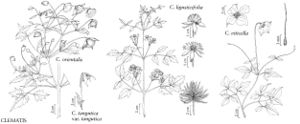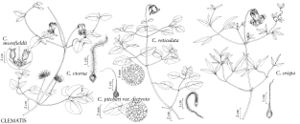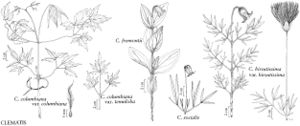Clematis
Sp. Pl. 1: 543. 175.
Gen. Pl. ed. 5, 242. 1754.
Vines, ± woody, sometimes only at base, climbing by means of tendril-like petioles and leaf-rachises, or erect, herbaceous perennials, from elongate rhizomes. Leaves cauline, opposite, simple or compound, sessile or petiolate. Leaf-blade undivided or 1-3-pinnately or ternately compound; leaf or leaflets cordate to orbiculate, oblong, lanceolate, or oblanceolate, lobed or unlobed, margins entire or toothed. Inflorescences axillary and/or terminal, 1-many-flowered cymes or panicles or flowers solitary or in fascicles, to 15 cm; bracts present and leaflike or ± scalelike or absent, not forming involucre. Flowers bisexual or unisexual, radially symmetric; sepals not persistent in fruit, 4, white, blue, violet, red, yellow, or greenish, plane, ovate to obovate or linear, 6-60 mm; petals absent; sometimes anther-bearing staminodes between sepals and stamens; stamens many; filaments filiform to flattened; pistils 5-150, simple; ovule 1 per pistil; beak present. Fruits achenes, aggregate, sessile, lenticular, nearly terete, or flattened-ellipsoid, sides not prominently veined; beak terminal, straight or curved, 12-110 mm. X = 8.
Distribution
Worldwide, mostly temperate, a few subarctic, subalpine, or tropical
Discussion
Species ca. 300 (32 in the flora).
Clematis is highly diverse in vegetative and floral aspects and has been divided into three or more genera by some authors, the groups segregated in some literature being Clematis subg. Atragene as the genus Atragene and Clematis subg. Viticella as the genus Viticella. Species in Clematis subg. Viorna have been crossed with highly dissimilar species in Clematis subg. Clematis and Clematis subg. Viticella, and species in Clematis subg. Clematis have been crossed with species in Clematis subg. Viticella. Chromosome morphology is strikingly similar in all subgenera.
The circumscription of subgenera in this work follows C. S. Keener and W. M. Dennis (1982). Major realignments have been proposed by F. B. Essig (1992) on the basis of seedling morphology, including the transfer of Clematis recta and C. terniflora to Clematis subg. Viorna.
Many species are valued as ornamentals; some have escaped from cultivation and have become established in the flora.
Selected References
None.
Lower Taxa
Key
| 1 | Sepals ± thick, leathery, connivent proximally and usually much of length; perianth bell- to urn-shaped, blue, violet, or yellowish white | Subg. Viorna |
| 1 | Sepals thin, spreading, not connivent; perianth widely bell-shaped to rotate, or if narrowly bell-shaped, bright yellow. | > 2 |
| 2 | Staminate flowers with petaloid staminodes between stamens and sepals; perianth widely bell-shaped or tardily rotate. | Subg. Atragene |
| 2 | Staminate flowers without staminodes between stamens and sepals; perianth rotate, sepals wide-spreading, or sepals recurved at least toward tip. | > 3 |
| 3 | Flowers 1–many (if flowers solitary, either unisexual or with yellow sepals), generally in cymes or panicles, unisexual or bisexual; sepals white or yellow, linear-oblong, elliptic, lanceolate, ovate, oblanceolate, or obovate. | Subg. Clematis |
| 3 | Flowers 1–3 (if 1, sepals not yellow), in axillary clusters, bisexual; sepals blue to violet, rarely white, broadly obovate to elliptic-rhombic. | Subg. Viticella |


